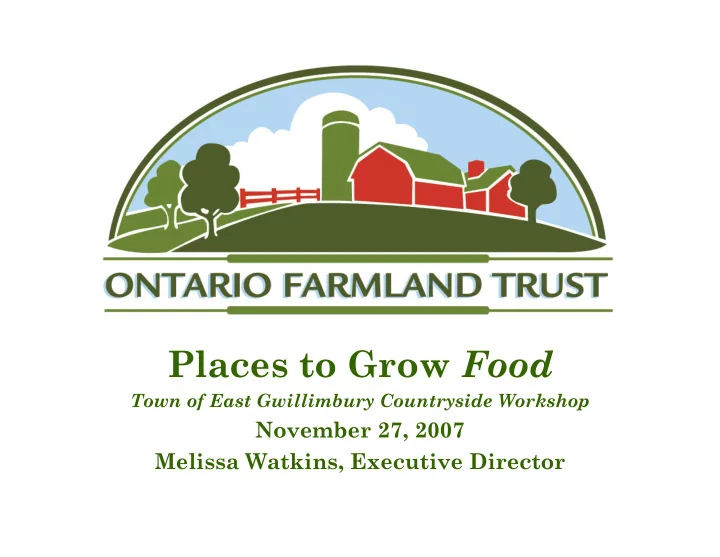

Ontario Farmland Trust Places to Grow Food Town of East Gwillimbury Countryside Workshop November 27, 2007 Melissa Watkins, Executive Director
Overview 1. Introduction 2. Why Preserve Places to Grow Food in East Gwillimbury 3. The Ontario Farmland Trust 4. Challenges and Opportunities
Policy Context • Provincial Policy Statement • Greenbelt Plan • Oak Ridges Moraine • Places to Grow (Built Boundary just announced) • Official Plan
Farmland in Canada and Ontario • Only 11% of Canada’s land can support agricultural production • Only 5% is “prime agricultural land” (classes 1-3 under the Canada Land Inventory • Only 0.5% of Canada’s land area is Class 1 farmland • Over half of the Class 1 farmland is in Southern Ontario • All of Canada’s 2 best agri-climatic zones • 70-85% of land being urbanized is Class 1
Ontario’s Unique Resource • Southern Ontario provides only half of one percent of Canada’s total farmland, but has 52% of our class one farmland! • Southern Ontario has ALL of the best two agro-climatic regions in Canada! • Together this makes southern Ontario the single most important agricultural resource in the country.
There are areas of concern… • Expansion of urban areas and loss of farmland (Ontario: 4 million more people anticipated in 30 years; EG: approx. 125,000 more in same time) • Farmland preservation until recently has had a low profile • Farmland loss is often seen as inevitable • Loss of farmers…but protection of farmland • Some municipalities have a poor track record (rural severances)
Patterns of Farmland Loss • Harder to figure our than you’d expect! • Subdivisions at the urban edge. • Impact of non-farm residents and traffic in the ‘urban shadow’. • Individual rural residential severances in agricultural zones. • Marginal farmland on poor soils reverting to forest cover. • The coming demographic retirement wave.
What are the Impacts of Non-Farm Uses on Agricultural Land? • Fragment land base & consume farmland • Potential conflict with agriculture • Can lead to changes in the rural community • Environmental and servicing impacts • Detract from rural aesthetic • Introduces restrictions on farmland
So… …Why Protect Places to Grow Food Why Protect Places to Grow Food So the Town of East Gwillimbury Gwillimbury? ? the Town of East • Food production • Food security • Economic contributions of agriculture • Stewardship & amenity of the countryside • A resource for current and future generations • A golden opportunity!
Ontario Farmland Trust: an option for permanently protecting farmland for agriculture
What is the Ontario Farmland Trust? • A non-profit land trust designed to focus on protecting farmland for farming. • Supported by key major farm organizations, with a Board of Directors about half farmers and half non-farmers. • Building a bridge between conservation and farming communities. • Strong ties to the University of Guelph’s Farmland Preservation Research Project.
Background • Establishment of University of Guelph Farmland Preservation Research Project in 2002 • Ontario Farmland Conservation Forum in 2002 • Incorporation July 19, 2004 • Qualified Eco-gift recipient in 2005 • Farmland Preservation Conferences in 2004 and 2005 • 2007: Working to secure first easements
To protect and preserve farmland and associated agricultural, natural and cultural features in the countryside, and to support research and education to further the preservation of these lands for the benefit of current and future generations.
We are just one piece of the puzzle that supports an extremely important and diverse industry. • Agriculture is the #2 sector of the Ontario economy, contributing over 700,000 jobs. • Agriculture supports both a healthy environment and rural communities. • To protect agriculture and farm communities in urbanizing southern Ontario we must protect farmland.
What We Do • Like other land trusts, with the same challenges of governance and funding. • Seek easements or outright ownership of farmland, both donated and purchased. • Focus on protecting farmland for agricultural production. • Run education & awareness programs.
Key Issues for the OFT •Near-urban agriculture •Support for government policy – Greenbelt, Pickering and issues related to near-urban agriculture – Agricultural Advisory Team – GTA Agricultural Action Plan – Growth Management Strategies •Agricultural easement legislation •Funding
Recent Government Legislation • The Greenbelt! • ‘Places to Grow’ • Revisions to the Planning Act and Provincial Policy Statement
What are the challenges in What are the challenges in preserving farmland? preserving farmland? • Until recently there was little legislative basis for protecting agricultural land; now Bill 16 has added ‘agriculture’ to the Conservation Land Act. • There is no financial incentive, unlike the Eco-Gifts Program, so farmland only gets protected because it’s part of a property containing a significant natural area.
The Future of Local Farming? Reconnecting the Farmer and Consumer -OR- Struggling to compete with International Commodities
Urban Attitudes to Farming – the Positive Side • Most urbanites and conservationists support farmers. • The main motivation cited for buying local food is to support the farmer. • Local food purchases in a variety of ways contribute to value-added farm income. • Urban support also protects the rural farm landscape.
Where Next? • Development of policy options and supportive programs to improve farmland protection. A Places to Grow Food Plan? • Agricultural policies that acknowledge the connections to health, food security, climate change, as well as the economic opportunities. • Support for farmers who are part of local food economy.
Any Questions? Thanks…
Executive Director: Melissa Watkins farmland@uoguelph.ca c/o University of Guelph, Richards Building Guelph, ON N1G 2W1 519-824-4120 ext. 52686 farmland@uoguelph.ca www.ontariofarmlandtrust.org
Recommend
More recommend